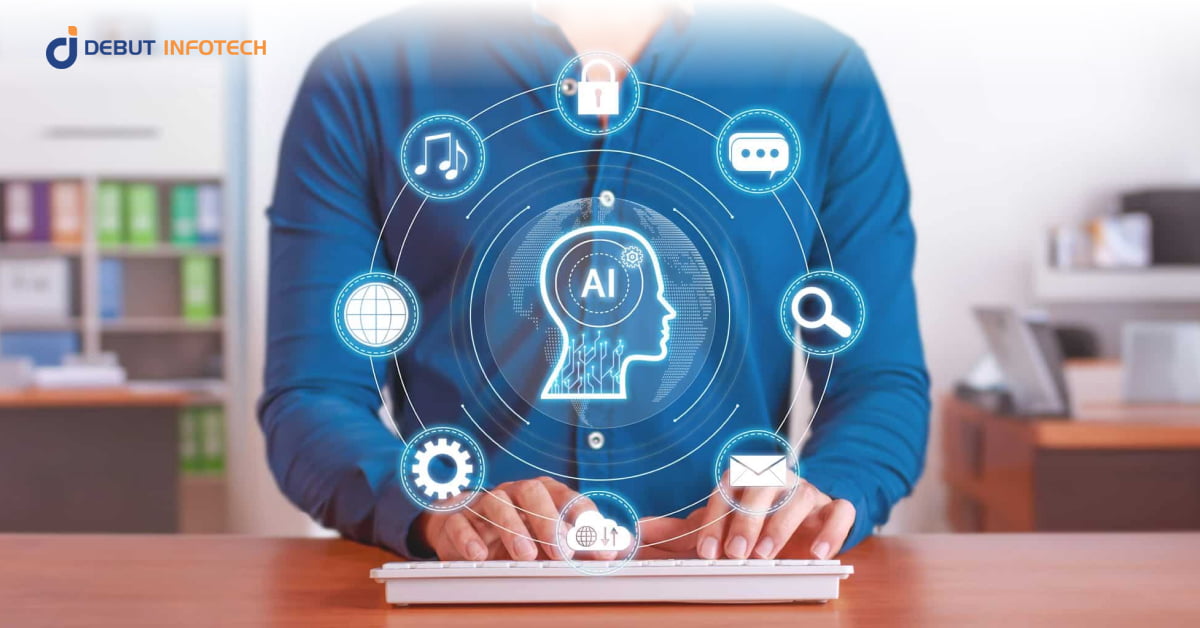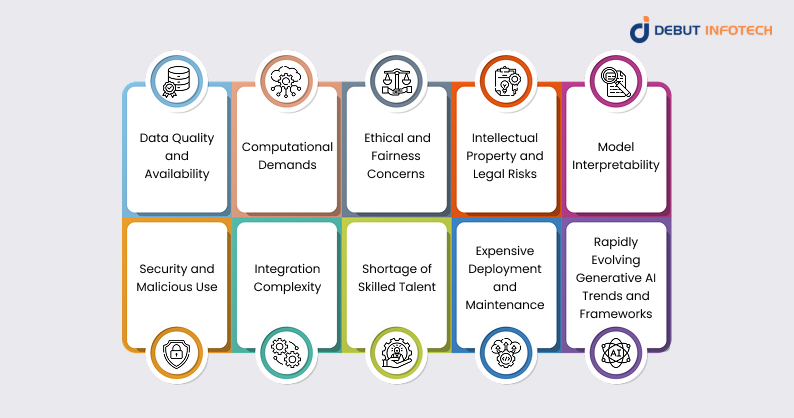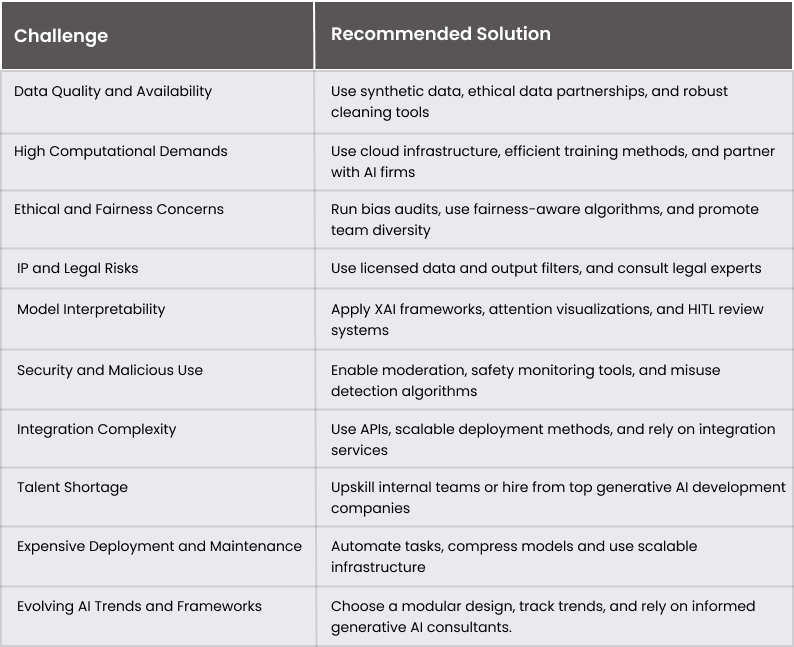Table of Contents
Home / Blog / AI/ML
Key Challenges in Developing Generative AI Models
May 21, 2025

May 21, 2025
Generative AI is an agent of true change across businesses, and the machines are capable enough of generating text, images, music, and code. Bearing massive existence and power, the generative AI models‘ route to development and implementation is cluttered with complexities. It is important for organizations that are seeking to utilize this technology to understand the challenges involved in developing generative AI models.
This in-depth guide explores the many challenges in developing generative AI models. Our scope extends from data quality to ethical concerns, computational challenges, and integration complexities as we discuss the critical issues developers and businesses must wade through. By illuminating these challenges, we hope to offer some insights that could guide stakeholders in making smart calls in the emerging terrain of generative AI.
Learn More About Generative AI Integration
Curious how to overcome the challenges in generative AI development and drive innovation in your business? Dive deeper into best practices, integration strategies, and real-world use cases.
What Are Generative AI Models?
Generative AI models are subdivisions of artificial intelligence defined by creating new pieces. Different from traditional AI that analyzes or classifies data, generative models can generate new outputs – text, voice, images, code, or video- based on the data they are trained with.
Popular Examples of Generative AI
- Text-to-speech models
- Image generation tools
- AI chatbots (like GPT-based models)
- Music generation systems
- Generative Adversarial Networks (GANs)
These models rely on advanced architectures such as transformers, GANs, VAEs, and autoregressive models to perform their creative tasks. With broad applications across industries like healthcare, finance, entertainment, and education, generative AI is poised to become a central component of the future of AI.
Benefits of Generative AI in Modern Business
While the challenges in generative AI are real, so are the rewards. Here’s how businesses are benefiting from its integration:
- Automation of creative tasks (copywriting, content generation)
- Improved customer service through AI-driven chatbots
- Personalized user experiences in eCommerce and entertainment
- Accelerated product design and prototyping
- Realistic simulations for training and education
With proper development and deployment, generative AI can be a game-changer. However, unlocking these benefits requires overcoming major technical and ethical roadblocks.
Related Read: KPIs for Generative AI: Measuring Business Impact & Strategic Value
Key Challenges in Developing Generative AI Models
Building advanced generative AI models is far more complex than simply training neural networks on large datasets. It involves tackling technical limitations, legal ambiguities, ethical dilemmas, and integration bottlenecks. Below, we examine the most pressing challenges in developing generative AI models that businesses, developers, and generative AI development companies face today.

1. Data Quality and Availability
Generative AI models thrive on high-quality, diverse, and well-labeled datasets. However, sourcing such data is a serious challenge. Poor data quality results in biased, inaccurate, or irrelevant model outputs — a major challenge in generative AI. Often, datasets are either too narrow, outdated, or legally restricted due to privacy regulations like GDPR or HIPAA.
Additionally, proprietary datasets owned by big tech firms give them an upper hand, leaving startups and smaller organizations at a disadvantage. Data annotation is the other bottleneck that requires tremendous human effort or specialized tools. It is without the correct data foundation that even the highest degree of complexity models will underperform.
2. Computational Demands
What are the main challenges in training generative AI models? The answer almost always includes the steep computational cost. Training large-scale models like GPT-4, text-to-speech models, or diffusion networks involves billions of parameters and demands massive GPU clusters, high-speed networking, and continuous power supply.
This infrastructure is expensive and energy-intensive. The financial and environmental costs of model training have sparked debates around sustainability and accessibility in AI. Only well-funded organizations can afford this scale of operation, further widening the gap between AI giants and emerging players.
3. Ethical and Fairness Concerns
Addressing fairness and bias is one of the most critical hurdles in generative AI. Developers often ask: “What is one challenge in ensuring fairness in generative AI?” The most evident answer is biased training data. If your dataset contains harmful stereotypes or underrepresented communities, the model will reflect and perpetuate those flaws.
Other ethical concerns include generating offensive, harmful, or false information, often referred to as “AI hallucination.” These biases can damage brand trust, spark controversy, and even result in legal consequences. Building inclusive, transparent, and accountable AI systems is a growing priority for generative AI development companies and regulators alike.
4. Intellectual Property and Legal Risks
One of the greyest areas of AI development is IP/content ownership. Generative models are trained on public or scraped data, such as copyrighted text, music, code, or images. The model’s reproduction of parts of this material may result in copyright infringement, lawsuits, or takedown requests.
This legal fuzziness should be particularly distressing for businesses providing commercial products based on generative AI. Law enforcement on AI-generated content is also in progress, but businesses must comply already. For that reason, companies usually hire generative AI consultants or legal experts.
5. Model Interpretability
One of the under-discussed but major challenges in developing generative AI models is their “black-box” nature. Deep learning architectures, especially transformers and GANs, are notoriously difficult to interpret. Understanding why a model made a particular decision or generated a specific output is far from straightforward.
This opacity hinders debugging, auditing, and improving model behavior. This can pose compliance risks in highly regulated industries like healthcare or finance. Explainable AI (XAI) frameworks are still in their infancy, leaving developers with limited tools to demystify these powerful systems.
6. Security and Malicious Use
The potential for misuse is another dangerous challenge in generative AI. These models can be exploited to create:
- Deepfakes and impersonations
- Fake news or propaganda
- Malicious code generation
- Phishing emails and scams
This raises the need for robust security measures, output monitoring, and ethical filters. Developers must incorporate safeguards to detect and prevent harmful use cases. At the same time, there’s a growing need for regulations to hold malicious actors accountable.
7. Integration Complexity
Even after development, embedding generative AI into real-world applications is anything but simple. Systems must interact seamlessly with APIs, databases, user interfaces, and existing business workflows. Scalability, latency, and user privacy must also be considered.
This makes implementation a multi-dimensional task requiring collaboration between developers, UX designers, legal teams, and business stakeholders. Many organizations rely on Generative AI Integration Services or specialized generative AI development companies to overcome these hurdles efficiently.
8. Shortage of Skilled Talent
Despite the hype around AI, there’s a shortage of professionals skilled in generative architectures, optimization techniques, and deployment frameworks. Demand for AI researchers, ML engineers, prompt engineers, and data scientists far exceeds supply.
This talent crunch forces companies to either heavily invest in training or hire generative AI developers externally. Partnering with a trusted AI development company like Debut Infotech helps bridge the gap by offering immediate access to pre-vetted experts.
9. Expensive Deployment and Maintenance
After training and testing, generative models need continuous attention. From retraining with fresh data to updating guardrails and monitoring for accuracy, post-deployment care requires a full operational framework. These ongoing tasks incur additional costs — including cloud fees, human oversight, and infrastructure scaling.
This makes AI adoption unsustainable for many small and mid-size enterprises unless they collaborate with cost-efficient generative AI development companies that offer end-to-end support and maintenance.
10. Rapidly Evolving Generative AI Trends and Frameworks
Keeping up with the generative AI trends and toolsets is itself a challenge. New generative AI frameworks, architectures, and techniques emerge frequently—from transformer upgrades and diffusion models to low-rank adaptation (LoRA) and retrieval-augmented generation (RAG). What was state-of-the-art six months ago may now be obsolete.
For developers and businesses, this means constant upskilling, tool migration, and adapting infrastructure. Without a forward-looking strategy, investments in tools and training can quickly become outdated. This is why working with experienced generative AI consultants or an adaptive AI development company becomes essential. They bring ongoing R&D insights and help future-proof your solutions with modular, scalable architectures.
Effective Solutions to Challenges in Developing Generative AI Models
While the challenges in generative AI development are complex, they’re not insurmountable. With the right tools, strategic planning, and expert partnerships, businesses can successfully develop and deploy generative models that are secure, scalable, and fair. Here’s how to overcome each challenge.
1. Solution for Data Quality and Availability
- Invest in synthetic data generation to supplement limited datasets.
- Use data cleaning and labeling tools to enhance quality.
- Collaborate with data providers who follow ethical sourcing practices.
- Ensure compliance with data protection laws through secure handling and anonymization techniques.
2. Solution for High Computational Demands
- Leverage cloud-based GPU and TPU services for scalable computing.
- Use efficient training techniques like transfer learning or model distillation.
- Opt for modular model architectures that allow partial retraining instead of full-scale rebuilds.
- Partner with an AI development company like Debut Infotech that provides infrastructure support.
3. Solution for Ethical and Fairness Concerns
- Implement bias detection tools and regular audits on datasets and outputs.
- Involve diverse teams in data labeling and model testing.
- Apply fairness-aware algorithms that reduce discriminatory outcomes.
- Maintain transparency through documentation and explainability frameworks.
4. Solution for Intellectual Property and Legal Risks
- Use licensed, open-source datasets or obtain rights for commercial use.
- Implement filters and plagiarism checkers on AI outputs.
- Work with generative AI consultants and legal experts to ensure compliance.
- Train models on proprietary or anonymized content to avoid replication of protected material.
5. Solution for Model Interpretability
- Use explainable AI (XAI) frameworks to visualize decision-making processes.
- Incorporate attention maps, saliency scores, and SHAP values to interpret outputs.
- Provide human-in-the-loop (HITL) mechanisms for sensitive decisions.
6. Solution for Security and Malicious Use
- Integrate output moderation systems and content filtering layers.
- Use prompt injection guards and context validation to avoid unsafe generations.
- Monitor usage through AI safety dashboards and flag suspicious behavior.
7. Solution for Integration Complexity
- Design APIs and microservices that allow a smooth connection with legacy systems.
- Use low-latency model deployment techniques like edge inference or serverless functions.
- Leverage Generative AI Integration Services to tailor-fit AI into your workflow.
8. Solution for Talent Shortage
- Hire generative AI developers with proven experience in relevant frameworks.
- Upskill internal teams by training them on popular tools like PyTorch, TensorFlow, and Hugging Face.
- Work with generative AI development companies like Debut Infotech to access expert resources without delay.
9. Solution for Costly Maintenance
- Automate tasks like performance monitoring and scheduled retraining.
- Use model compression techniques to reduce computational expenses.
- Choose a pay-as-you-go infrastructure for better budget control.
10. Solution for Rapidly Evolving Trends and Frameworks
- Adopt modular architectures that allow easy component updates.
- Subscribe to open-source and research communities for early trend insights.
- Partner with a forward-looking generative AI development company that stays updated with the latest breakthroughs.
Summary Table: Challenges and Solutions in Generative AI

Why Debut Infotech Is a Trusted AI Development Company
As an experienced AI development company, Debut Infotech helps businesses navigate these generative AI challenges with ease. Whether you need adaptive AI development, robust generative AI frameworks, or want to create powerful generative AI models, our team delivers tailored, scalable, and secure solutions.
From ideation to deployment, Debut Infotech supports businesses with:
- End-to-end generative AI development services
- Custom model training and optimization
- Legal and ethical compliance
- Seamless integration with your existing tech stack
Need Expert Help? Let’s Talk
Whether you’re looking to hire generative AI developers or need a full-scale generative AI development company, Debut Infotech is here to help.
Conclusion
The challenges in developing generative AI models are diverse, from technical limitations and ethical concerns to legal risks and operational costs. Still, these obstacles are not insurmountable. With the right strategy and a trusted technology partner like Debut Infotech, your organization can harness the full potential of generative AI to transform operations, boost creativity, and drive business innovation.
As the future of AI continues to unfold, staying informed about the latest generative AI trends and technologies is essential. Whether you’re just starting or scaling an enterprise-level solution, understanding the core issues and addressing them head-on is the first step to success.
Frequently Asked Questions
A. The key challenges in developing generative AI models include data quality and availability, high computational demands, ethical and fairness concerns, intellectual property and legal risks, model interpretability, security and malicious use, and integration complexity. Each challenge requires specialized solutions like ethical data sourcing, advanced computational infrastructure, and ensuring transparency and fairness in model outputs.
A. Data quality directly impacts the performance of generative AI models. If the data used for training is biased, incomplete, or poorly labeled, the model’s outputs can be inaccurate, biased, or irrelevant. Ensuring diverse and high-quality datasets is crucial to achieving fair, accurate, and reliable AI outputs.
A. Generative AI models, especially large ones like GPT-4 or image generation models, require massive training computational resources. This involves high-performance GPUs and substantial memory. The cost and availability of such resources can be prohibitive for smaller businesses or startups, making it a significant challenge in developing cutting-edge models.
A. A major challenge in ensuring fairness in generative AI is addressing biases in training data. If the data used to train the models lacks diversity or represents certain demographics disproportionately, the model can produce biased outputs. This can result in unethical or discriminatory applications, which must be corrected through bias audits and fairness-aware algorithms.
A. Reducing security risks in generative AI involves implementing safety mechanisms such as output moderation systems, content filtering, and misuse detection. Building AI models with robust prompt injection guards and establishing monitoring frameworks can also help detect and mitigate potential malicious uses like deepfakes or misinformation generation.
A. Integrating generative AI into existing systems can be complex due to differences in architecture, scalability issues, and compatibility with legacy systems. Businesses must design APIs and microservices to facilitate smooth integration and ensure the AI model can operate efficiently within their existing workflows. This often requires customization and collaboration with AI development companies.
A. To overcome the shortage of skilled generative AI developers, businesses can train and upskill their existing teams, hire specialized AI developers, or collaborate with experienced generative AI development companies. Outsourcing to AI firms with access to top-tier talent is another effective solution for businesses lacking in-house expertise.
Talk With Our Expert
Our Latest Insights
USA
2102 Linden LN, Palatine, IL 60067
+1-708-515-4004
info@debutinfotech.com
UK
Debut Infotech Pvt Ltd
7 Pound Close, Yarnton, Oxfordshire, OX51QG
+44-770-304-0079
info@debutinfotech.com
Canada
Debut Infotech Pvt Ltd
326 Parkvale Drive, Kitchener, ON N2R1Y7
+1-708-515-4004
info@debutinfotech.com
INDIA
Debut Infotech Pvt Ltd
Sector 101-A, Plot No: I-42, IT City Rd, JLPL Industrial Area, Mohali, PB 140306
9888402396
info@debutinfotech.com





Leave a Comment